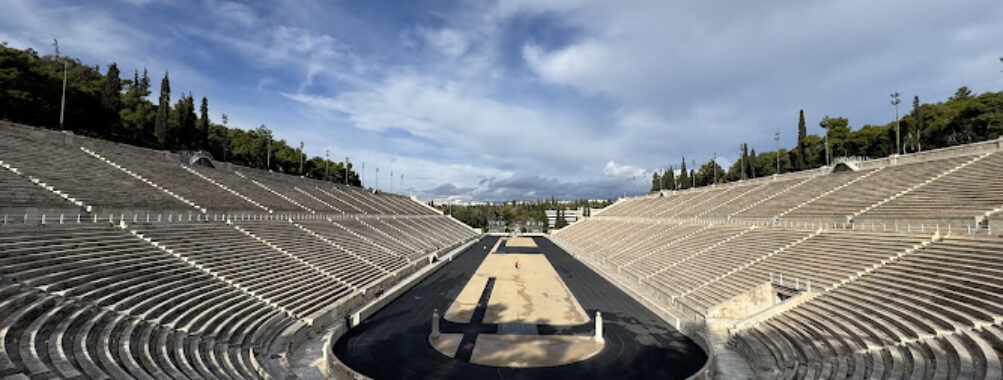
Panathenaic Stadium
Description
As you wander through the heart of Athens, it’s hard to resist the draw of the Panathenaic Stadium. This isn’t just another monument—it’s an enduring symbol of athletic spirit, monumental history, and striking architectural beauty. Sometimes referred to as “Kallimarmaro” (meaning “beautifully marbled”), the stadium is entirely built from white Pentelic marble. As you step inside, you can almost hear the echoes of ancient crowds and athletes running under the Greek sun.
The stadium stands on Leoforos Vasileos Konstantinou, a verdant avenue surrounded by gardens and neoclassical structures. Its roots reach back over two millennia to 330 BC, when it hosted the Panathenaic Games to honor the goddess Athena. But perhaps what gives the Panathenaic Stadium its legendary status is its role as the venue for the first modern Olympic Games in 1896. Today, it’s still a hub for ceremonial Olympic events and an uplifting experience for travelers curious about Greece’s rich heritage.
Key Features
- World’s Only All-Marble Stadium: The Panathenaic Stadium is unique—every tier and seat carved from shimmering white marble, offering a visual grandeur you won’t forget.
- Olympic Legacy: The site of the 1896 Olympics, and still an integral part of the torch relay ceremony for every Summer Olympics. Walking the track feels like stepping into living history.
- Audio Guide: I recommend picking up the audio guide at the entrance. It’s thoughtfully narrated with anecdotes, detailed history, and even a snippet of crowd noise for flair.
- Museum: Hidden beneath the stands, the small museum houses a captivating collection of Olympic torches dating back over a century, as well as memorabilia from past games.
- Panoramic Views: Climb to the topmost rows (there are 50!) and you’ll be rewarded with sweeping views over central Athens, including iconic sights like the Acropolis in the distance.
- Accessibility: The stadium features wheelchair-accessible entrances and parking so everyone can enjoy its wonders.
- Photo Opportunities: The track, ancient seats, finish line, and statues offer endless chances for memorable photos—especially when the afternoon light hits the marble.
Best Time to Visit
From my visits, I’ve learned that the experience at the Panathenaic Stadium changes dramatically with the season and time of day. Early mornings tend to be the quietest. If you arrive when the gates open, you can almost have the echoing stands to yourself, which makes the atmosphere feel even more monumental.
Athens summers can get scorching, and the marble radiates heat. I suggest avoiding midday in June, July, and August. Spring (April-May) and autumn (late September-October) hit a sweet spot: pleasant temperatures and manageable crowds.
If you’re a runner or fitness enthusiast, the stadium sometimes opens its track to locals during select hours. Running a lap where Olympic champions once competed is a thrill you won’t soon forget. For those interested in ceremonial events, the lighting of the Olympic flame and the marathon finish line festivities are real highlights, but do check the schedule in advance as dates vary.
How to Get There
The Panathenaic Stadium sits right at the edge of Athens’ historic core, making it easy to reach whether you’re staying in Monastiraki, Plaka, or near Syntagma Square.
- Walking: If you’re up for a stroll, it’s a pleasant 15-20 minute walk from Syntagma Square, passing the National Garden and the Zappeion along the way.
- Metro: The closest metro stations are Evangelismos (Line 3) and Syntagma (Lines 2 and 3). From either station, it’s about a 10–15 minute walk.
- Bus/Trolley: Numerous buses and trolleys stop on Leoforos Vasileos Konstantinou or nearby Vasilissis Olgas. Buses A5, 209, and 550 are reliable options.
- Taxi or Ride-Share: Taxis are affordable in Athens. If you’re short on time or traveling with family, simply asking for “Kallimarmaro” will get you there without confusion.
- Parking: There is a designated parking lot with spaces for visitors, including accessible parking. Spaces fill up quickly during events.
Tips for Visiting
- Wear Comfortable Shoes: The marble steps can be slippery and the stadium is much larger than it appears from the entrance. If you plan to explore the upper tiers, expect a bit of a climb.
- Bring Sun Protection: There’s almost no shade, especially on the track. A hat, sunglasses, and sunscreen are must-haves during spring and summer.
- Don’t Miss the Museum: It’s easy to overlook the small museum entrance under the stands, but you’ll regret missing the timeless collection of Olympic torches and uniforms.
- Audio Guides Enhance the Visit: Available in several languages, these guides provide context you can’t get just by wandering. They make the history come alive even for kids.
- Great for Families and Groups: Kids love racing each other on the original track, and there’s plenty of space for group photos in the stands.
- Photography: Visit late in the afternoon for the best light as the sun illuminates the marble. If you’re visiting for the Olympic flame handover, bring a zoom lens for the best candid shots.
- Accessibility: Entrances and parking are wheelchair-friendly, though navigating the higher seating areas may require assistance due to steep, uneven steps.
- Read the Plaques: Take time to read the informational signs scattered throughout the stadium. They’ll point out details you might otherwise walk past—like where marathon runners cross the finish line every November.
- Combine With Other Sites: The location is close to attractions like the National Garden, Temple of Olympian Zeus, and the Zappeion. Plan a half-day to enjoy the area fully.
Every time I return to the Panathenaic Stadium, I’m reminded just how powerfully it links Athens’ past with its present. Whether you’re a history buff, a sports enthusiast, or simply love a good walk through ancient grandeur, this legendary stadium offers a uniquely Greek blend of mythology, memory, and marble.